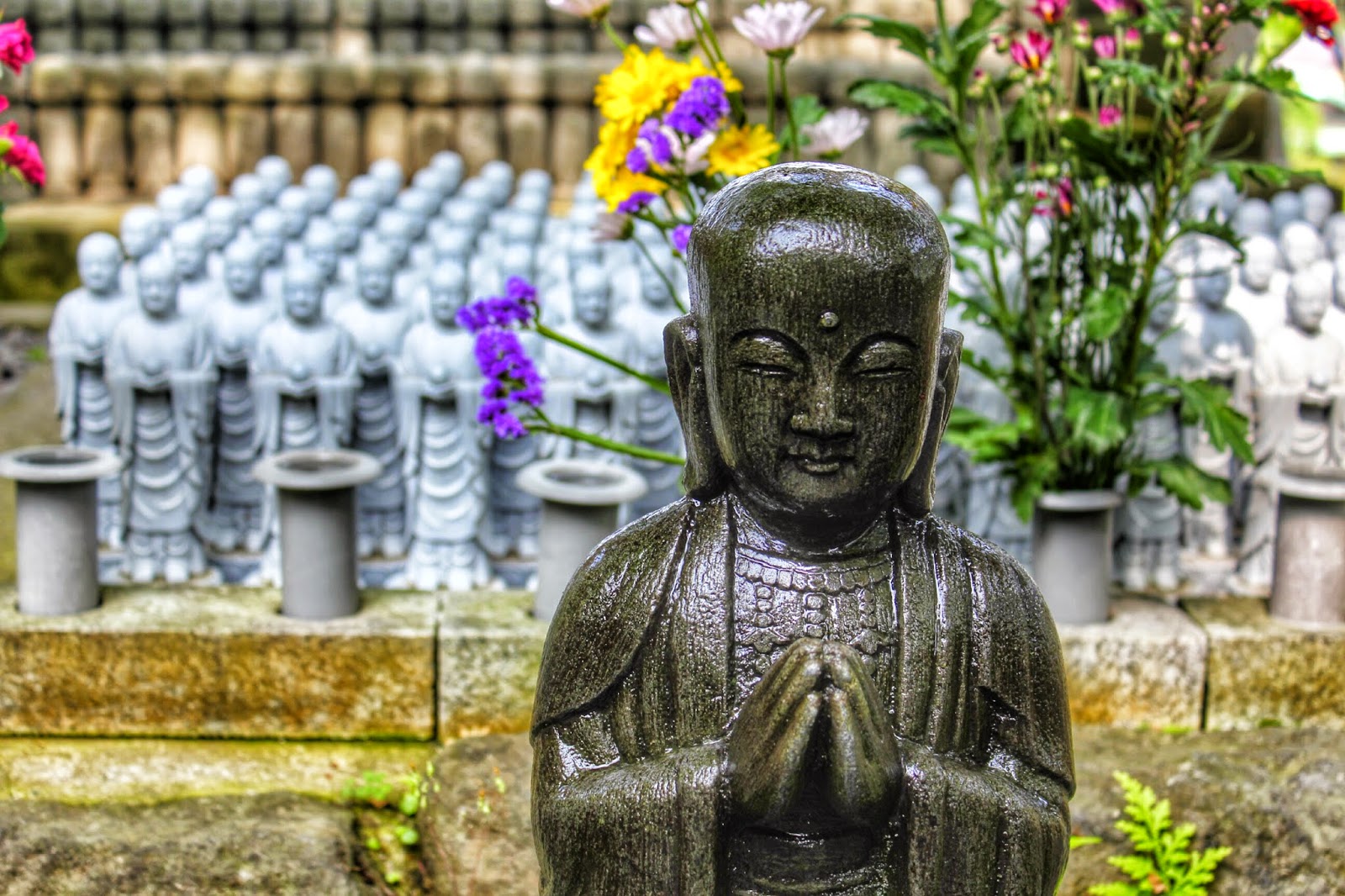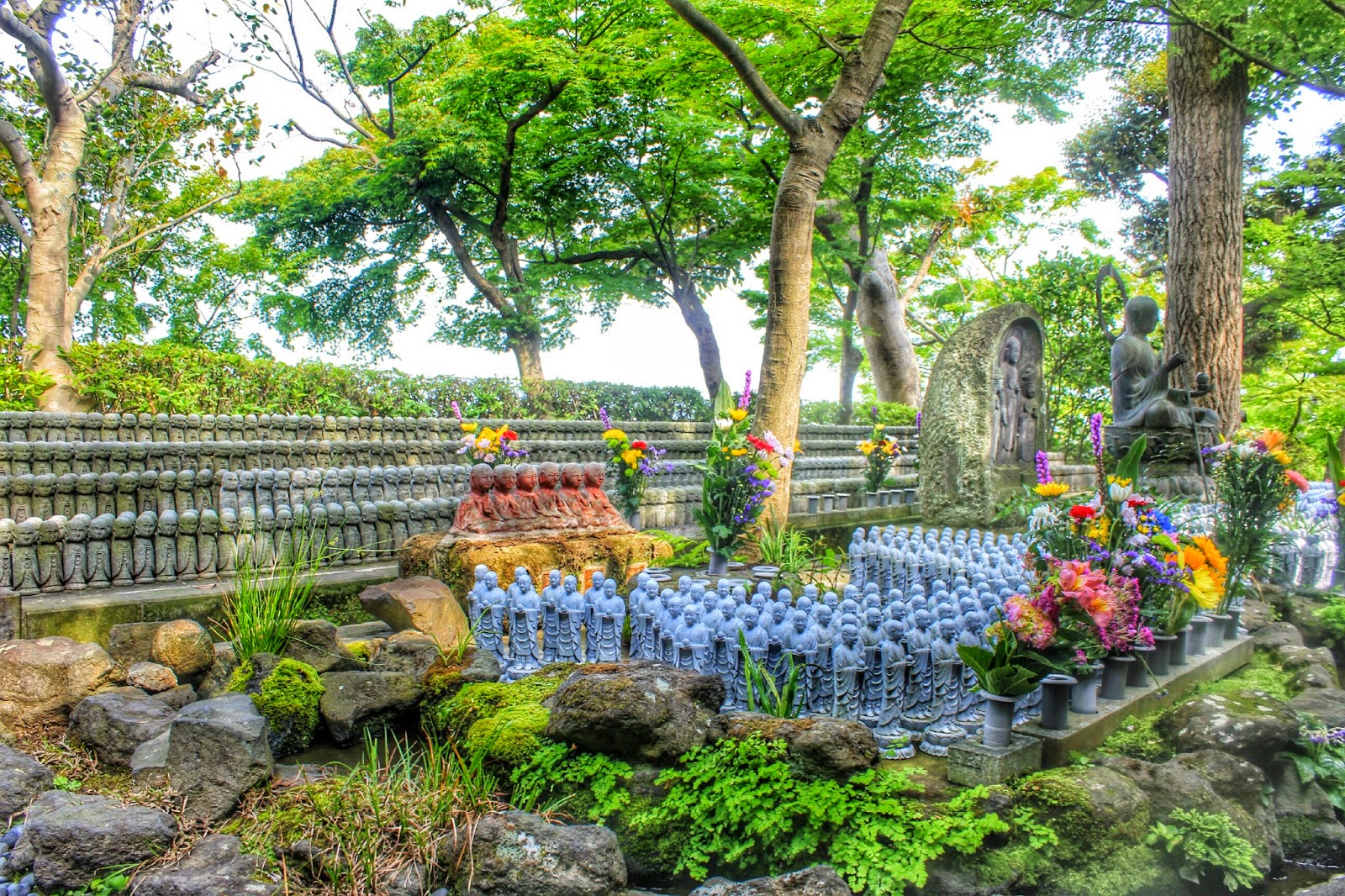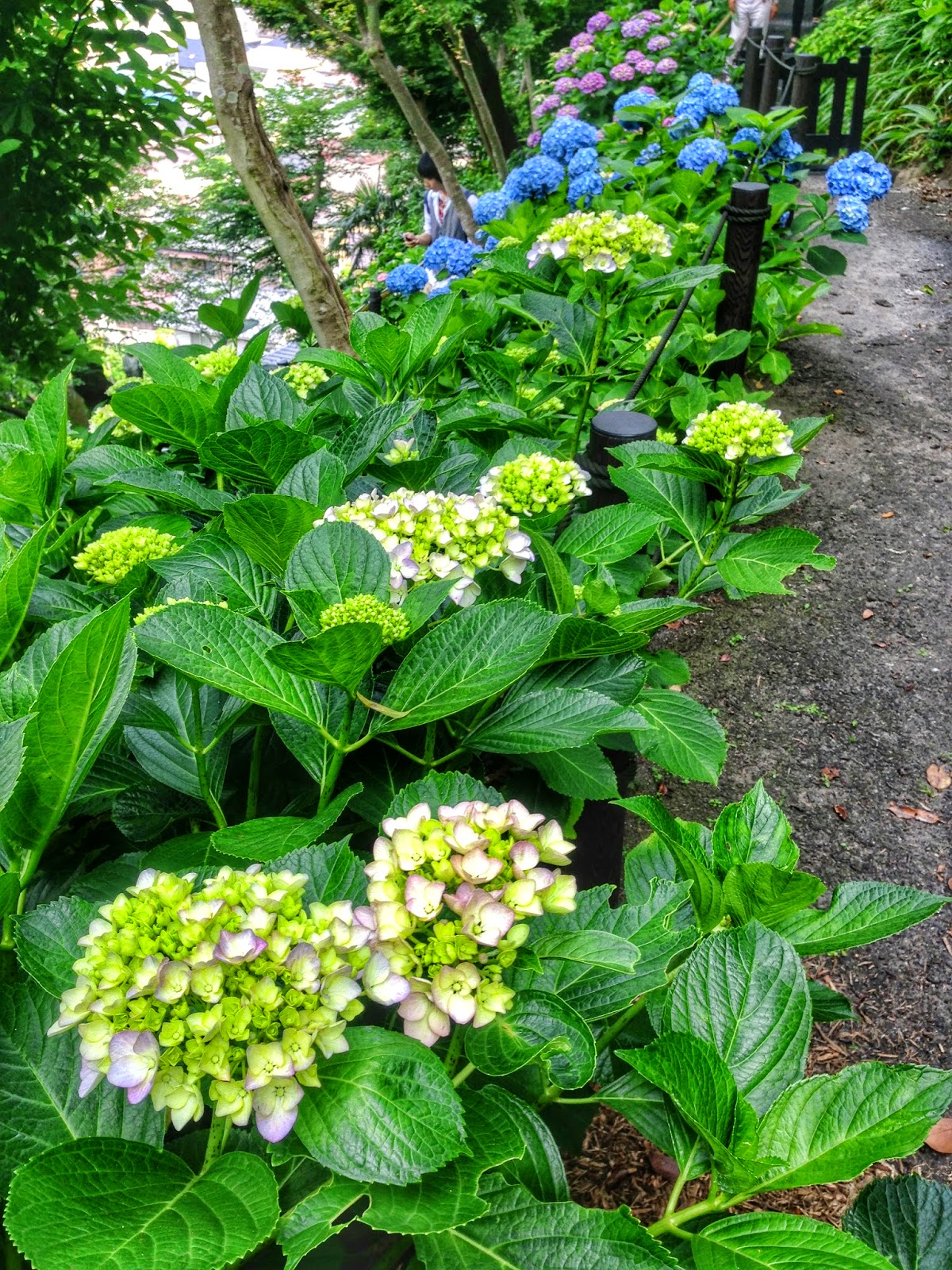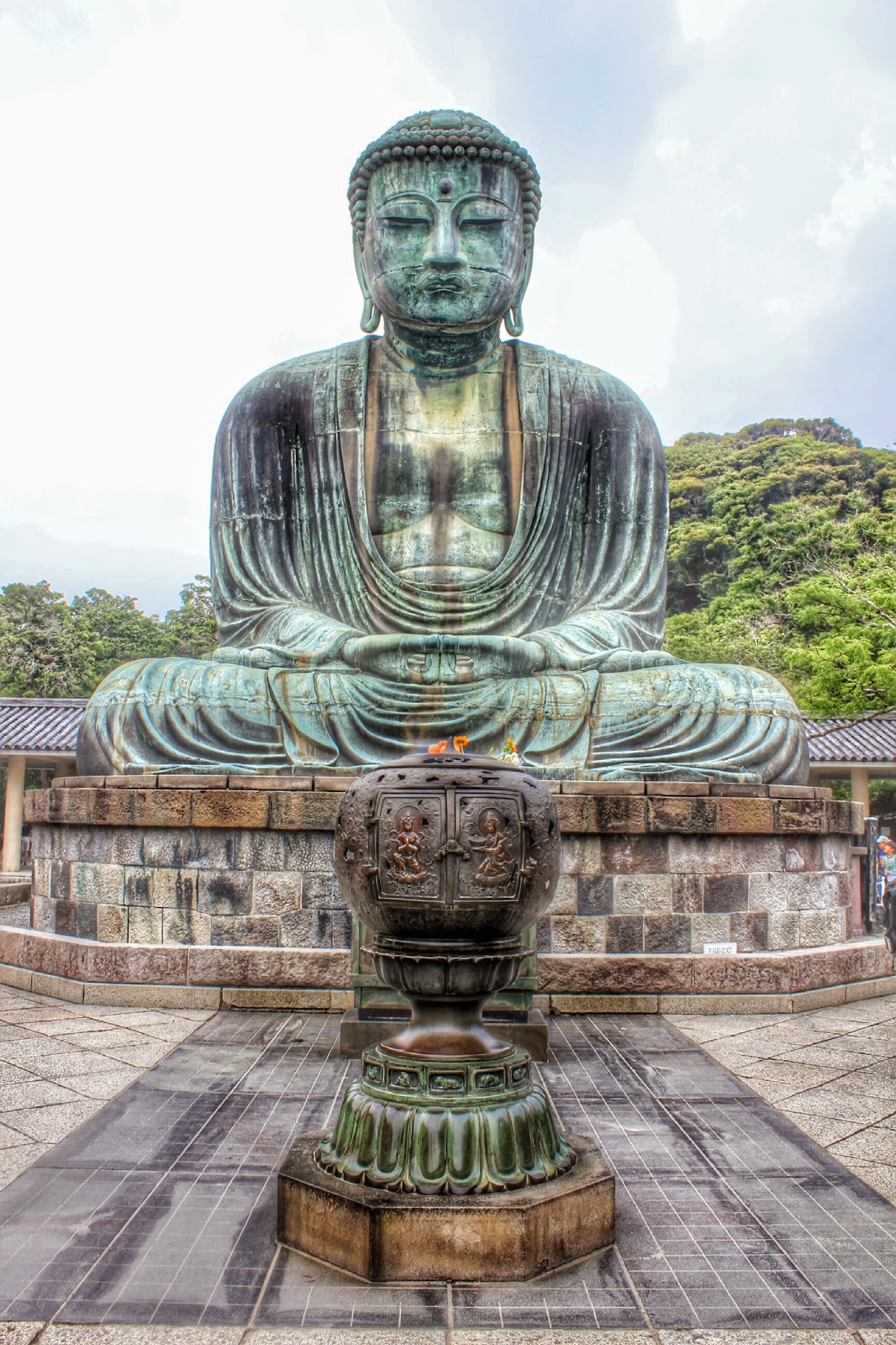 |
| Blissful Jizo Bodhisattva Statues at Hase-dera Temple |
My second stop at Kamakura after the Tsurugaoka Hachiman-gu shrine was the beautiful Hase-dera temple. The temple was built on a wooded hill and it's main draw is the 9.18 meter wooden statue of Kannon (Goddess of Mercy). It has eleven heads, each representing the different characteristic of the Goddness.
To reach the temple, we took Kamakura's trademark train via the Enoden (Enoshima Electric Railway Station) from the Kamakura station to the Hase station. The ride was rather unique as it cut through the residential district and the railway track was in touching proximity of the houses. I guessed the residents must have already got themselves immune to the rumbling sound every time a train passed by their houses.
 |
| Enoden |
The ride took about 10 minutes. We have to walk for another 10 minutess to reach the Hase-dera temple. There were shop houses selling souvenirs and foods along the way but we skipped them, having our fill already at Komachi-dori. One thing I learnt from this trip was how to already differentiate a Shinto shrine from a Buddhist temple at the entrance. A Shinto shrine always has a Torii to mark it's entrance whereas a Japanese Buddhist temple has beautifully decorated gate, often flanked by two Godly or Demonic guardians and trademarked by a red lantern in between the entrance.
 |
| Front Gate of Hase-dera Temple |
 |
| Photo at Hase-dera Temple's front gate |
 |
| Picture Map of Hase-dera Temple |
The front gate of Hase-dera temple was beautifully decorated with fauna and flora. A big lantern hanging in between the gate indicated that it was a temple devoted to Buddhism. We paid the entrance fee via an electronic ticket counter (Adult: 300 Yen, Child: 100 Yen) and went into the temple through the side gate. A beautiful garden greeted us but we did not spend too much time in it. Instead, we went straight for the stairs to climb uphill to the main temple.(
Side note: I did not often support the charges for temples' visits. A temple is a religious ground where people from all aspects of background can offer their prayers and respect to the gods. I have experienced temples at Thailand, China, Japan etc charging for temple visits. I hope the money collected are put to good use like helping the poor and maintaining the temple ground but not for business profits)
 |
| Jizo Bodhisattva Statues#1 |
 |
| Jizo Bodhisattva Statues#2 |
 |
| Jizo Bodhisattva Statues#3 |
 |
| Jizo Bodhisattva Statues#4 |
 |
| Jizo Bodhisattva Statues#5 |
At the middle of the hill, I was drawn to the many small Buddha status that lined the slope and ground of the hill. They were Jizo Bodhisattva statues contributed by devotee to help the souls of dead children to reach paradise. We would see many of these in various versions in the temple ground. My wife took sometime to bath a Buddha statue with a ladle from the crystal clear pool. We spent quite a while here admiring the scene before continued our climb up the stairs.
 |
| Kannan-do Hall |
 |
| Photo at Kannan-do Hall |
The uphill climb was not arduous and we soon reached the main temples. There were two main halls-the Kannan-do hall (which housed the famous Goddess of Mercy statue) and the Amida-do hall. No photography was allowed in the Kannan-do hall. The imposing and finely crafted statue towered over the visitors and was very well-preserved. The Japanese have spent great effort to preserve their treasures and heritage and set a good example for many others to follow. There is another similar statue carved out from the same camphor tree housed in another temple at Nara.
 |
| View over Kamakura City |
There was an observation deck which overlooked the city and the sweeping view of the nearby ocean. We took the opportunity to take a breather at one of the many benches stationed there. We could see many people buying snacks from a nearby small restaurant while enjoying the wonderful scenery. We resisted the temptation as we had plans for a sushi feast for dinner! We saw many Kites hovering around in the sky and there were Warning Signs to warn people of the aggressive birds. These applied specially for those who did not want the Kites to disturb them with their razor sharp claws while enjoying their snacks.
 |
| Photo with beautiful Hydrangeas |
 |
| Hydrangeas#1 |
 |
| Hydrangeas#2 |
 |
| Hydrangeas#3 |
 |
| View from Top Platform |
I was preparing to leave but was told by Alison and Charlotte that they had discovered another path further uphill. We explored further and were glad we did not leave earlier. The pathway was adjourned with colourful and pretty hydrangeas at both sides which led to a top platform. The girls could not resist the lure of the flowers and dashed to pose with the ones they liked. Poor me (with my heavy camera equipments and bags) have to keep up with them while they complained "how slow I move and why I was not not taking photos of them" :-S The narrow stairs and steeper slope did not deter us from reaching the top. But I was sure I must have lost a couple of fats as I was sweating profusely. From here, we could capture the bird eye view of Kamakura with the sea and their famous flowers. I found out later that one would need to take a Q-number to admire the flowers during the peak period. We were lucky to avoid that situation. Note that hydrangeas are at full bloom during the June period only. Plan your time nicely if you want to witness their beauty and glamour.
 |
| Buddha statues near hill bottom |
We wished to stay here longer but running a bit out of time for our next destination-
The Kotokuin Temple and the Big Daibutsu. I strongly recommend you to put this beautiful temple in your list when you visit Kamakura next time.
 |
| For Your Pinning |



























































